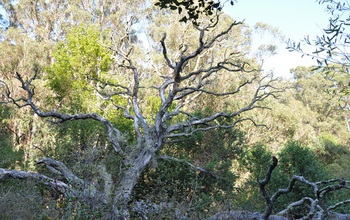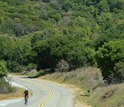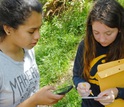Hola amigos: A VUELO DE UN QUINDE EL BLOG., la Fundación Nacional de Ciencias de Los Estados Unidos, están alarmados por la muerte súbita de árboles de roble en California.
NSF, nos dice: La muerte repentina del roble, tenga cuidado.
Ciencia Crowdsourced ayuda a predecir la trayectoria de la enfermedad de las plantas mortal, lo que demuestra los aportes ciudadanos científicos entrenados pueden hacer a los proyectos de localización geográfica a gran escala.
Esa es la conclusión de un estudio de monitoreo de la muerte repentina del roble en California. Los resultados se publican en la edición de este mes de la revista Frontiers in Ecology y el Medio Ambiente.
Ciencia Crowdsourced ayuda a predecir la trayectoria de la enfermedad de las plantas mortal, lo que demuestra los aportes ciudadanos científicos entrenados pueden hacer a los proyectos de localización geográfica a gran escala.
Esa es la conclusión de un estudio de monitoreo de la muerte repentina del roble en California. Los resultados se publican en la edición de este mes de la revista Frontiers in Ecology y el Medio Ambiente.
More information...........
http://www.nsf.gov/discoveries/disc_summ.jsp?cntn_id=134947&WT.mc_id=USNSF_52&WT.mc_ev=click
Citizen scientists assist with research on infectious plant disease
 Credit and Larger Version |
May 1, 2015
The following is part 16 in a series on the NSF-NIH-USDA Ecology and Evolution of Infectious Diseases (EEID) Program. See parts: one, two, three, four, five, six, seven, eight, nine, 10, 11, 12, 13, 14, and 15.
Sudden oak death, beware.
Crowdsourced science is helping to predict the path of the deadly plant disease, demonstrating the contributions trained citizen scientists can make to large-scale geographic tracking projects.
That's the conclusion of a study of sudden oak death monitoring in
California. The results are published in this month's issue of the
journal Frontiers in Ecology and the Environment.
Ebola of the plant world
"Sudden oak death is the Ebola of the plant world, the most serious threat to non-agricultural plants," says lead paper author Ross Meentemeyer, director of the Center for Geospatial Analytics at North Carolina (NC) State University.
The disease, which has killed millions of oak and tanoak trees in
California and Oregon, can infect up to 60 landscape plant species and
spread from nursery stock to residential landscapes.
Starting in 2008, University of California (UC), Berkeley,
researchers expanded their sudden oak death monitoring efforts
exponentially, thanks to observations from 1,600 trained volunteers who
collected leaf samples from trees in metropolitan and urban wildland
areas.
Citizen scientists often needed in research
"To answer many science questions, we need the efforts of a large number of people--and the general public can help," says Sam Scheiner, National
Science Foundation (NSF) director for the NSF-NIH-USDA Ecology and
Evolution of Infectious Diseases Program, which funded the research.
"This study shows that asking local residents to report on the
locations of outbreaks of sudden oak death can provide critical
information. The result is a better understanding of the spread of this
serious plant disease."
Adds Meentemeyer, "We were able to get data from backyards in the San Francisco Bay area, along with other locations.
"Those data were used to develop accurate computer
models for the disease's spread, showing that properly trained and
educated citizen scientists can collect data that's just as reliable as
that of professionals."
Predictions allow for targeted treatments
Accurate predictions about sudden oak death's spread allow scientists
to target treatments to the most vulnerable areas, says paper co-author
and forest pathologist Matteo Garbelotto of UC Berkeley.
The annual Sudden Oak Death Blitz, which includes extensive publicity during peak periods for the disease, involves high-school students, homeowners, tree specialists, firefighters, teachers and others.
Follow-up evaluation showed that trained citizen scientists were as
effective as experts in identifying and collecting diseased tree leaves,
whether or not they reported having a professional background in
science.
Additional authors of the paper are Monica Dorning and John Vogler of NC State and Douglas Schmidt of UC Berkeley.
| -- | Cheryl Dybas, NSF (703) 292-7734 cdybas@nsf.gov |
| -- | D'Lyn Ford, NCSU (919) 513-4798 dcford@ncsu.edu |
Investigators
David Rizzo
Ross Meentemeyer
Related Institutions/OrganizationsRoss Meentemeyer
University of California-Davis
University of North Carolina at Charlotte
Related Awards #0622677 Collaborative Research: Sudden Oak Death: Feedback Between a Generalist Pathogen, Hosts, and Heterogeneous Environments at Multiple Spatial and Temporal Scales
#0622770 Collaborative Research: Sudden Oak Death: Feedback Between a Generalist Pathogen, Hosts, and Heterogeneous Environments at Multiple Spatial and Temporal Scales
Total Grants $1,649,209
Related WebsitesNSF Special Report: Ecology and Evolution of Infectious Diseases:
http://www.nsf.gov/news/special_reports/ecoinf/
NSF News: Racing ahead of disease outbreaks: $12 million in new research grants:
http://www.nsf.gov/news/news_summ.jsp?cntn_id=132570&org=NSF&from=news

A hillside in Big Sur, Calif.,with many of its trees dead as a result of sudden oak death.
Credit and Larger Version

Thousands of oaks and tanoaks have been infected at the popular China Camp State Park, California.
Credit and Larger Version

California bay laurel infected with sudden oak death; bay leaves help spread the disease.
Credit and Larger Version

Spore produced by the pathogen, or disease-causing agent, of sudden oak death.
Credit and Larger Version

Young citizen scientists locating and collecting leaves with symptoms of
Credit and Larger Version
The National Science Foundation(NSF)
Guillermo Gonzalo Sánchez Achutegui
ayabaca@gmail.com
ayabaca@hotmail.com
ayabaca@yahoo.com
Inscríbete en el Foro del blog y participa : A Vuelo De Un Quinde - El Foro!

No hay comentarios:
Publicar un comentario